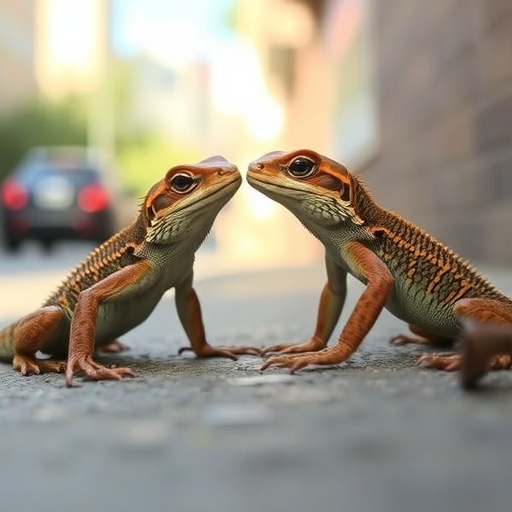In the intricate labyrinth of urban life, where concrete and steel dictate the rhythm of existence, one might assume that wildlife struggles to cope, let alone thrive. However, emerging research disrupts this perception by revealing remarkable behavioral adaptations in species often overlooked within cityscapes. The common wall lizard (Podarcis muralis), a small reptile traditionally seen as fiercely territorial and typically solitary, challenges these assumptions through its surprising social dynamics in urban environments. This phenomenon was meticulously documented in an observational study conducted by researchers from Bielefeld University and affiliated institutions, specifically focusing on lizard populations inhabiting urban versus natural habitats in Croatia.
The study’s results are compelling: wall lizards inhabiting cities form more complex social networks compared to their countryside counterparts. Utilizing social network analysis—a rigorous behavioral research methodology that maps interpersonal interactions and connectivity—the researchers uncovered that urban lizards establish more frequent and enduring interactions. These lizards demonstrate higher tolerance levels and exhibit a proclivity for group cohesion, a behavior traditionally alien to their species, which normally favors territorial exclusion and social avoidance.
This social shift appears to be an adaptive response to the peculiar constraints of urban ecosystems. Unlike the open and resource-rich countryside, cities present a mosaic of sealed surfaces, sparse vegetation, limited refuges, and highly fragmented resources such as food and basking spots. These spatial and resource limitations force lizards into proximity, necessitating the negotiation of social boundaries and fostering unprecedented interactions. The ecological pressures of urban landscapes, therefore, act as selective stimuli reshaping behavioral strategies, pushing these reptiles into newfound sociality and tolerance.
From a behavioral ecology standpoint, this phenomenon challenges long-held views about territoriality in Podarcis muralis. The urban lizards’ increased network density and stronger bonds signify not only a behavioral plasticity but also suggest a potential evolutionary trajectory under anthropogenic influence. The capability to adapt socially might confer significant survival advantages in habitats where competition for scarce resources is inevitably intense, and the costs of aggressive exclusion rise sharply.
The research also highlights the significance of urban environments as natural laboratories for studying species adaptation. The layering of anthropogenic structures over natural habitats creates unique ecological niches that necessitate modifications in morphology, physiology, and behavior. These lizards exemplify how animals can exploit niches carved out by human activity, transforming challenges into opportunities. Ultimately, these adaptations underscore a broader trend of urban wildlife navigating and thriving within man-made landscapes, reflecting a delicate balance between anthropogenic pressures and natural resilience.
Methodologically, the team leveraged social network analysis tools commonly applied in ethology and sociology to quantify interaction patterns. By monitoring spatial positioning and proximity data, the study delineated the frequency, duration, and intensity of contacts among individuals within urban and rural populations. This quantitative approach provided robust evidence of enhanced social interaction in urban settings, contrasting with the sparse contacts observed in non-urban environments. Such analytical rigor allowed for extrapolation beyond anecdotal observations, framing sociality as a tangible, measurable trait responsive to environmental context.
The lead author, Avery Maune, emphasizes that these behavioral shifts are not merely ecological curiosities but hold profound implications for urban conservation and management. Understanding how species alter their social strategies facilitates insights into their capacity to persist amidst accelerating urban expansion. These findings suggest that conservation frameworks must integrate behavioral flexibility as a key factor underpinning species’ resilience to habitat alteration and fragmentation, especially in rapidly urbanizing regions.
Furthermore, the interdisciplinary collaboration—incorporating expertise from behavioral biology, ecological niche theory, and urban ecology—provided a comprehensive perspective on this phenomenon. Contributions from researchers across institutions in Germany, Croatia, and Switzerland enriched the study’s analytical depth, linking local ecological observations to broader theoretical frameworks through the Collaborative Research Center NC³. This consortium’s focus on niche choice, conformance, and construction further contextualizes the lizards’ behavioral adaptation within the dynamics of ecological niche reshaping driven by environmental pressures.
The implications extend beyond lizards. This case study adds to a growing body of evidence pointing towards urban landscapes as crucibles of rapid behavioral evolution. As cities continue to expand globally, deciphering how animals modulate social and ecological strategies becomes vital for understanding urban biodiversity patterns and ecosystem functionality. Such knowledge informs not only academic discourse but also urban planning, biodiversity conservation, and wildlife management policies.
Intriguingly, these findings prompt questions regarding the genetic and neurological basis for such behavioral plasticity. Future research might investigate whether urban populations exhibit heritable traits favoring sociality or if these behaviors arise solely through phenotypic plasticity and learning. Such investigations are crucial to uncovering the mechanisms facilitating these rapid adaptations and their potential long-term evolutionary consequences.
This study’s insights illuminate a fundamental truth about urban ecology: the interplay between environment and behavior is dynamic, nuanced, and context-dependent. Far from being mere recipients of urbanization’s adverse effects, many organisms actively reshape their social and ecological niches, illustrating resilience and adaptability in unprecedented ways. The common wall lizard, through its urban sociability, exemplifies nature’s capacity to innovate behavioral strategies amid human-dominated landscapes.
In conclusion, the research underscores the necessity of reimagining urban environments as complex ecosystems where behavioral evolution unfolds visibly. Appreciating the nuanced social lives of urban lizards enriches our understanding of adaptation and survival strategies in anthropogenic habitats. As cities burgeon and encroach upon wild spaces, such studies provide critical insights into fostering coexistence and sustaining biodiversity in our rapidly changing world.
Subject of Research: Animals
Article Title: City lizards are more social
News Publication Date: 24-Sep-2025
Web References: 10.1098/rsbl.2025.0326
Image Credits: Marc Gilles
Keywords: urban ecology, Podarcis muralis, social network analysis, behavioral adaptation, urban wildlife, territoriality, animal social behavior, ecological niches, habitat fragmentation, species resilience




